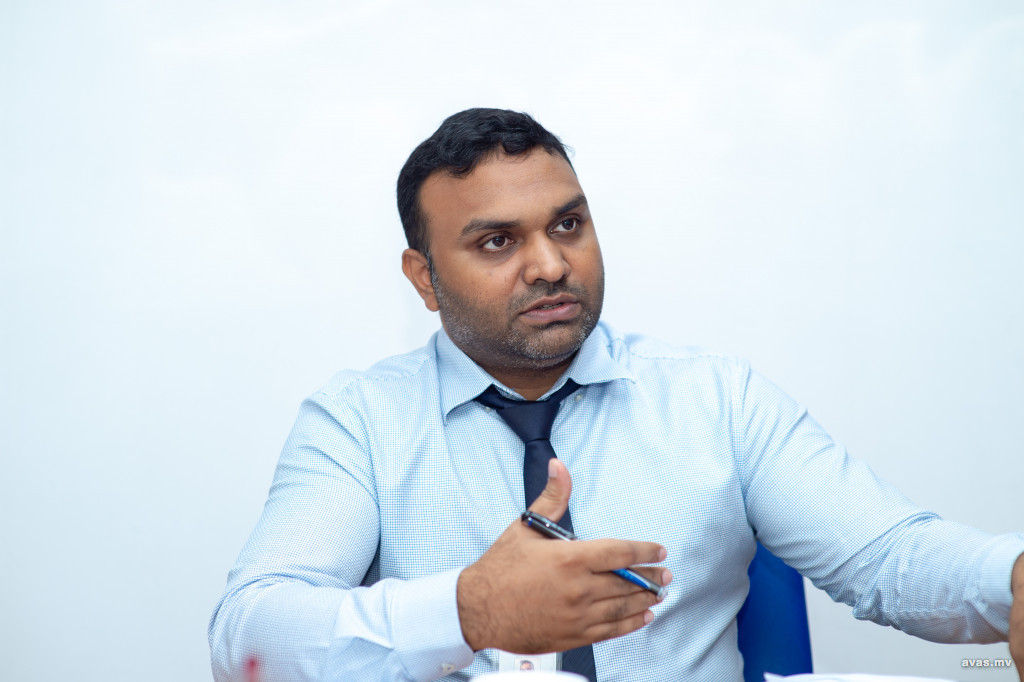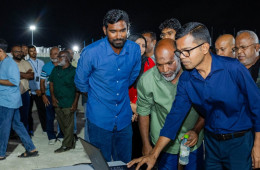The amount of electricity being consumed in the Maldives keeps increasing year on year. According to statistics released by state power company, STELCO, the electricity consumption increases by an average 7 percent every year, thereby increasing the electricity load. Therefore, it is always a challenge for STELCO to find means to ensure that the provision of electricity remains uninterrupted despite the burden on it. Spending millions to procure generator sets, these equipment are arranged on the limited grounds of STELCO, again constraining the limited space available in a congested Male’. While STELCO’s ‘territory’ has already been used up to install existing generators, there is no choice but to think of an alternative solution to the issue due to the lack of available space.
In order to find a feasible solution to the issue, STELCO entertained the possibility of interconnecting capital Male’ and reclaimed suburb Hulhumale’ via underwater cabling. STELCO’s books attest that the company pursued the project to an extent by having an American company conduct a study on it. However, the daunting costs and the work that would have had to be done to achieve the project and other challenges delayed the implementation of the project. However, when a project to link Male’ and Hulhumale’ via the China-Maldives Friendship Bridge began, the dormant project was once again illuminated with rays of hope. When then president of the Maldives, Abdulla Yameen Abdul Gayyoom decided that an electricity network will be established between either side of the bridge, the biggest project undertaken in the Maldives to interconnect Male’ and Hulhumale’ via an electrical network was born.
The project kicked off on July 31, 2016 with a joint venture between China’s Dongfeng and NWPA tasked with the responsibility of making the project a reality. The project, in its first phase, aims to interconnect the power grid of Male’, airport island Hulhule’ and Hulhumale’ via cabling. Powerful distribution systems and transformers are being installed under the project. The electricity network will have the capacity to carry 100 megawatts of electricity.
Managing Director of STELCO, Hassan Mughunee told AVAS that the delivery and installation of transformers are now underway. Transformers will be strategically placed in Male’, Hulhule’ and Hulhumale’, with two transformers installed at each location. Powerhouses are being constructed in both Male’ and Hulhumale’, and are nearing completion, he added.
The transformers were delivered to Maldives on a vessel hired especially for the purpose. Special vehicles had to be imported just for the purpose of unloading the heavy transformers and transporting them to its destination. Electrical cabling of over 18 kilometers in length necessary for the interconnection were also imported.
What makes this project special? Why is this project so important for the Maldives? How does the project help the Greater Male’ Region, where over 80 percent of the country’s population resides? How would the project help businesses? What are the advancements that would come to the country’s electrical system and infrastructure?
Hope for a solution to electricity issues
The ‘cable ends’ of this mega-project are connected to the 50-megawatt powerhouse established last year in Hulhumale under the ‘Fifth Power Electrical System’ project. The powerhouse is already in use, and provides power to Hulhumale’. However, only 15 megawatts of electricity generated by the powerhouse are currently being utilized by Hulhumale’. Therefore, it is STELCO’s aim to use the surplus power to find a swift solution to the electricity issues faced by Male’. Another purpose of the project is to minimize the five-yearly cost and time spent on procuring and installing new engines to keep up with the demand for power by increasing its capacity. MD Mughunee assures that the project will effectively address the electricity issues in Male’ and will ensure uninterrupted service to residents of Male’.
“Male’ city is so congested. There is no more space available to develop infrastructure to produce electricity. When the network is interconnected, space will be freed up to develop an additional powerhouse if needed. This interconnection would be very helpful and will resolve power interruption issues,” he said.
Interconnecting Gulhifalhu Port and Male’
The Greater Male’ Interconnection Project is not limited to just Male’, Hulhule and Hulhumale’. While a commercial harbour is being developed in reclaimed Gulhifalhu, the government has also initiated work to construct the country’s second overwater bridge to link Male’ with industrial island Thilafushi. The Interconnection project will extend to these locations. Mughunee said the powerhouse in Male’ will also be able to adequately cater to the four wards of Male’ under the project.
“This is the completion of a large part of the Greater Male Region’s security. Phase II of this project will interconnect Villimale and Thilafushi and Gulhifalhu. As soon as the current phase concludes, the next phase will be immediately implemented,” said Mughunee.
New 50 megawatt generator to be installed in Hulhumale’
Hulhumale’ currently accommodates a 50 megawatt powerhouse. However, enough space is available to install a new engine to keep up with the electricity load that stems from Male’. STELCO is prepared to undertake the necessary work.
STELCO’s General Manager Abdul Malik Thawfeeq said the company no longer entertains the idea of installing a new generator in Male’.
“STELCO is now preparing for the second phase of the project. This would allow us to upgrade the existing capacity by 50 megawatts. This would give a total of 100 megawatt to this region.The cable has the capacity to cater to the consumption. Therefore, this is a national power grid that is being established; this is 11,000 volts. The interconnection has a 132,000 volt cable. This is quite a high jump,” said Malik.
Malik said the higher the voltage, the lower the loss would be, allowing a larger transfer of current.
The biggest advantage of the project is that electricity can be supplied to all islands in the grid if a power failure or other technical issues arise. If the power fails in Male’, the national grid would enable the supply of electricity to Male’ even from Gulhifalhu.
The new electricity network would modernize and advance STELCO’s services. The company’s ‘Distribution Starter Automation’ project will link all power distribution in Male’ and Hulhumale’ remotely via computers.
“Even in the case of a power failure in Male’, the engines can be swiftly restarted. Currently, the engines have to be restarted manually. But this system would allow for distribution via a computer screen. This is a very dynamic sistem, this is the larger picture,” said Malik.
Most of the equipment of the US$ 44 million project have already reached Maldives. The link road between the bridge and Hulhumale’ displays the cables necessary for this project. The project was previously scheduled to reach completion by this November. However, travel restrictions due to the COVID-19 pandemic caused unforeseen delays. In order to expedite the progress, STELCO arranged for specialised engineers needed for the project to travel to the Maldives via a chartered flight. The project is now expected to reach completion by the beginning of 2021.









